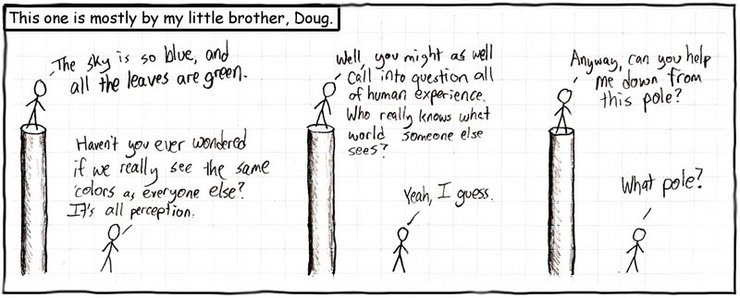 You look at an apple, and you don't see "an apple". You have no perceptions that can tell you what something is, you can only tell what it looks like, smells like, how it behaves; in other words, all you get about the apple is that part of it which impinges, in one way or another, on your senses. You perceive not an apple but the appearance of an apple.
You look at an apple, and you don't see "an apple". You have no perceptions that can tell you what something is, you can only tell what it looks like, smells like, how it behaves; in other words, all you get about the apple is that part of it which impinges, in one way or another, on your senses. You perceive not an apple but the appearance of an apple.But so what? Every time you perceive an apple, it's the same thing as other people perceive when they perceive an apple, and the same as you perceive when you perceive an apple. So, when all is said and done, does anything change at all when you amend your definition of an apple to include "the thing which I seem to perceive as..."? No, not really. Since everything is pushed back one level of abstraction together, the result is exactly the same as it was.
Now consider a lump of wax. You can't know what it really is, only what you perceive it as. And yet, what is that? Heat it up, and every aspect of what it looks like changes. The color will thin out, it may even turn transparent. The texture becomes far more shiny and glossy. The shape will completely transform as it melts. The feel is entirely different. So too its sound and smell and even, if you dare to try it, its taste.
This brings us back to where we started: does there need to be an essence behind the appearance? Perhaps there is, but its absence changes nothing for us, who are limited to our perceptions. As Nietzsche wrote in answer to the question of what appearance is, "Certainly not the opposite of some essence: what could I say about any essence except to name the attributes of its appearance! Certainly not a dead mask that one could place on an unknown x or remove from it!"
 It seems plain to me that there is no immutable essence to the wax. Speaking in absolutes, the wax now is not the wax that was there a moment ago. The apple is not the apple you saw earlier. And you are not the same person you were when you started reading this post. Change cannot be divided, save arbitrarily, between small and large changes, changes to essence and changes only to appearance; this is a difference of quantity only. While you're reading this sentence, billions of changes are happening in your body, changes which cannot be reversed. You will never be precisely what you were before those changes. That a particular atom of carbon is a nanometer farther to the left now is a change, differing only in quantity, not kind, from that you had your appendix taken out, or that you decided you don't like art nouveau. Even if you hadn't melted the wax, it still would have been changing, just not as much. There is no unity of the organism, there are only changes that haven't gotten big enough to perceive yet, or that we choose to ignore.
It seems plain to me that there is no immutable essence to the wax. Speaking in absolutes, the wax now is not the wax that was there a moment ago. The apple is not the apple you saw earlier. And you are not the same person you were when you started reading this post. Change cannot be divided, save arbitrarily, between small and large changes, changes to essence and changes only to appearance; this is a difference of quantity only. While you're reading this sentence, billions of changes are happening in your body, changes which cannot be reversed. You will never be precisely what you were before those changes. That a particular atom of carbon is a nanometer farther to the left now is a change, differing only in quantity, not kind, from that you had your appendix taken out, or that you decided you don't like art nouveau. Even if you hadn't melted the wax, it still would have been changing, just not as much. There is no unity of the organism, there are only changes that haven't gotten big enough to perceive yet, or that we choose to ignore.This is not a new idea, of course. Heraclitus put it in its most famous form: "You cannot step twice into the same river; for other waters are continually flowing in."


 RealTime and RTC
RealTime and RTC Prism
Prism Uncreated
Uncreated Bloodweavers
Bloodweavers Foulspawner's Legacy
Foulspawner's Legacy Lusternia
Lusternia
2 comments:
Buddhist epistomology sheds some enlightenment on this subject; I'll check my sources on my glorious return.
That's a pretty nice use of my candle photo, glad you like it.
Post a Comment